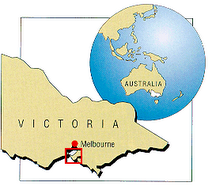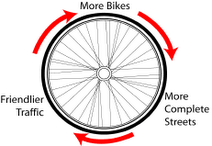"Many of these short car trips could comfortably be completed by bicycle," says program director Rosemarie Speidel.
"We're at this stage now where we want to accommodate bikes without infringing on cars, but if you want to get more people riding bicycles to achieve modal shift then you are going to have to give preferential treatment to bicycles."
According to Cycling Promotion Fund, contrary to popular belief, cycling has not been a long-standing 'tradition' in many northern European countries such as Netherlands and Denmark.
By the 1960s, many European cities and towns were overun by cars , causing pollution and congestion.
In response State and Local governments began the process of providing alternatives to car use, through innovative transport policy.
 A carrot and stick approach of restricting car use, whilst simultaneously improving bicycle infrastructure bought new life to many cities. In Amsterdam and Copenhagen, both these cities report 20-30% of all trips are now conducted by bicycle.
A carrot and stick approach of restricting car use, whilst simultaneously improving bicycle infrastructure bought new life to many cities. In Amsterdam and Copenhagen, both these cities report 20-30% of all trips are now conducted by bicycle.In Northern Europe cycling is now common despite weather conditions of frequent rain, and snow. Austraia's climate is far more favourable yet our cycling rate is considerably lower.
Successful tranport strategies recognise that building more roads is a poor solution to congestion and pollution problems.
Sensible transport policy focuses on moving people not cars. The most efficient , equitable and healthy transport modes are cycling and walking, yet they receive only a small fraction of the funding provided for car based infrastructure. Moreover as petrol prices continue to rise, Australia's car dependent communities will be placed in anextremely vulnerable position.

Even the USA, traditionally viewed as the home of 'car is king' culture, is starting to invest billions of dollars in walking and cycling facillities, with the adoption and reauthorisation of the State Accountable, Flexible, Efficient Transport Act. (SAFETEA-LU), and growing support for Safe Routes to School programs and non-motorised transport projects.
Despite strongly imbalanced funding, bicycle culture is beginning to take hold in Australia. ABS data shows Australians purchased more bikes than cars for each of the last 5 years.
The evidence from Australia and overseas is clear - car culture can be changed when people are provided with other options. They are willing to reduce their car use and cycle more when provided with the supportive environment. With the emerging issues of congestion, obesity, climate change and spiralling fuel prices, there has never been a better time to challenge car culture through investment in cycling encouragement programs.
What would get more people cycling?
I see the priorities in these items:-
- Traffic calming with CBD & shopping area speed limits at 30kph, (even innner city congestion levies such as London and Singapore have).
- End of trip facilities, storage and change rooms (new & renovated CBD buildings now must have this, but they must be made available to users not locked away or used as storerooms and garbage lockers as is now the case in observed in several Melb CBD buildings)
- Extensive driver education to raise awareness of bicyclist's use of the roads and relevant road rules
- Improving bicyclist's knowledge, skills and safe cycling behaviour with courses and refresher training in the wider community and amongst workplace and community bicycle user groups (BuGs)
- Use of the Bike BUS for commuting bicyclists.

- Heavy Goods Vehicles have a greater onus in vicinity of vulnerable road users. (eg: suggestion: must steer clear of vulnerable road users and have an absolute liability to reduce speed in vicinity of pedestrians and bicyclists to a max of 30klph in communities and 60 klph on country roads).
- Traffic enforcement regulations that heavily favour pedestrians and bicyclists, with a burden of primary liability on the driver of all motorised vehicles, as is so successfully used in Europe.
- Restrictions on motor vehicle use & limited parking. ( by cost and restrict expansion of parkingstations and closure of many existing stations) - (Note: these are already cash cows to big business and councils, so it is hard to see them co-operating )
- More people riding to their neighborhood shops for local shopping and grocery purchases, cuts demand for parking stations and relates to the reality of the average purchase being made for items that are easily carried in a back pack or basket
Notice, I havnt advocated for heavy infrastructure development or expenditure!.
I say this because it is established that not only are separation facilities expensive, they have limited benefits over the detrimental effect on bicycle and pedestrian behaviour.
Separation like Copenhagen style lanes may reduce riders exposure to vehicles but they also limit the on road experience, many riders thus do not learn how to behave in on road riding situations. Pedestrians are more inclined to enter dedicated bicycle paths and Copenhagen lanes as they are not threatened by the bicycle as opposed to cars. Paths and separation lanes increase the risk of collision at intersecting road junctures with cars as drivers and riders do not have preparedness to look out for each other as they have been separated.
On road painted bicycle lanes force riders into the car door danger zone, and drivers cease to look out for riders as they are no longer in the full traffic lane, drivers thus drive closer to bicycles and faster, putting the rider at higher risk.
Plus, and most important, separation by Copenhagen lanes and paths further widen the expectation between driver and rider in that drivers expect riders to not be on the road at all. Drivers of cars then expect a free run at all times, and claim the road is no place for bicycles when they have a place of their own, no matter how unsafe it is.
Separation creates and exacerbate danger, it doesn't alleviate it.
According to Forester, "Instead of fighting with cars, you cooperate with other drivers, so that you all get home safely. Participating in, cooperating with the traffic system, obeying the same rules of the road as other drivers, acknowledging their rights while claiming your own, that's the key to safe and confident cycling in traffic. Vehicular cycling, so named because you are acting as the driver of a vehicle, just as the traffic laws require, is faster and more enjoyable, so that the plain joy of cycling overrides the annoyance of even heavy traffic.
Cyclists fare best when they act and are treated as drivers of vehicles.
That is the guiding principle that cyclists should recognize and government and society should obey. But government does its best to prevent cyclists from recognizing this principle. Motorists fear that competent cyclists would delay them.
Riders fair best on the roads when they ride as vehicles in a vehicular fashion. "
I go along with that as the fundamental principle that should guide all riding/drving experiences. The age of car monopoly is over. Cars now must be driven differently, if it means slower and with greater onus for liability on the driver so be it.
We owe it to future generations to deliver a vibrant healthy place to live with the prospect of safe and viable transport choices that support health and wellbeing...reducing reliance and abuse of motorcar use and adopting a bicycle and/or walking would go along way towards that!
On yer bike..you will be glad you did









No comments:
Post a Comment